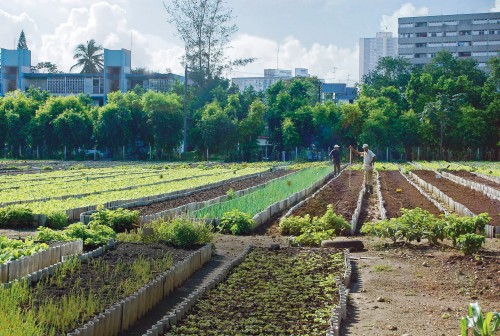Unlike rural farming, urban agriculture is completely integrated into the urban ecology and economy. It is the practice of cultivating plants and rearing animals within or around cities and towns. Organic waste and waste water are used as compost as well as for irrigation. Other useful urban resources are also utilised in this type of farming. Interestingly, regular city dwellers like businessmen, government and non-government employees, housewives, etc. are both producers and consumers.

Types of urban agriculture
Urban farming or agriculture can be broadly classified as:
- Intra-urban is the agriculture within the city or town such as private gardens, backyards, owned or leased private land. It can be carried out at public or semi-public areas such as school compounds, conservation areas, parks, broad road-side pavements, etc.
- Peri-urban is a form of agriculture in the sub-urban regions close to city or town such as along the highways, railways, etc.
Production and consumption
Regular food products such as vegetables, fruits, grains, root crops, etc. or non-food products such as ornamental plants, medicinal herbs, etc. are grown in urban agriculture. Raising domestic animals like cattle, poultry, goats, sheep, fish, etc. is also included under urban agriculture. There is no exclusivity as a plot dedicated to this kind of agriculture can be used for a combination of any two or all of these activities.
Urban agriculture is not just a part-time care for the environment but complete process cultivation that includes marketing and sales. In some situations, processing of food items is also a part of the cycle. Packing, delivery and sales of food or non-food products are integral to urban agriculture, which has been conceptualised to facilitate sustainability in cities and maintain balance between urban and rural areas.
Presently, all or major urban agricultural products are utilised for self-consumption, i.e., to be consumed by the producer. However, it has immense potential for market-oriented volume-production, a system that can become a part of mainstream economy. In fact, it is fast emerging as an industry and considerable number of co-operative agencies, though not fully organised and comprising of only a few people, is already in operation. The products grown or animals reared in urban agriculture are sold on carts by green grocery retailers and supermarkets in the same or other neighbourhood.
Significance of urban agriculture
Urban agriculture is a viable option to cope with unemployment or job-insecurity, food insecurity, ecological issues, etc. in the developing and poor countries. Estimation reveals that by 2020, 75% of the population in Latin America, Asia and Africa will live in urban regions. Urban agriculture provides food for self-consumption for poor and tight-budgeted families. The excess or the remainder can be bartered or sold for competitively low price due to no or significantly small transportation costs. If streamlined and mainstreamed, urban agriculture can constitute significant fraction of urban economy.
Urban farming offers the best scope for urban organic waste management as the organic waste can be used as compost. Moreover, all of this opens avenues of employment. Lastly, it is of great significance towards various urban ecosystems the ecology as a whole. Conclusively, urban agriculture can be said to be an entirely productive and positive practice.

COMMENTS